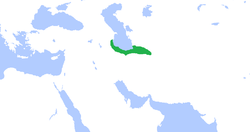Dabuyid dynasty
Dabuyid dynasty | |||||||||||||||
|---|---|---|---|---|---|---|---|---|---|---|---|---|---|---|---|
| 642–760 | |||||||||||||||
 The Dabuyid dynasty around its greatest extent under Farrukhan the Great | |||||||||||||||
| Capital | Fuman (660–760)[1] | ||||||||||||||
| Common languages | Middle Persian, Caspian languages, Tabari | ||||||||||||||
| Religion | Zoroastrianism | ||||||||||||||
| Government | Monarchy | ||||||||||||||
| Ispahbadh | |||||||||||||||
• 640-660 | Gil Gavbara (first) | ||||||||||||||
• 740/41-759/60 | Khurshid (last) | ||||||||||||||
| Historical era | Middle Ages | ||||||||||||||
| 642 | |||||||||||||||
• Abbasid conquest | 760 | ||||||||||||||
| |||||||||||||||
| Today part of | Azerbaijan Iran Turkmenistan | ||||||||||||||
Part of a series on the | ||||||||||||||||||||||||||||||||||||||||||
|---|---|---|---|---|---|---|---|---|---|---|---|---|---|---|---|---|---|---|---|---|---|---|---|---|---|---|---|---|---|---|---|---|---|---|---|---|---|---|---|---|---|---|
| History of Iran | ||||||||||||||||||||||||||||||||||||||||||
 | ||||||||||||||||||||||||||||||||||||||||||
| BCE / BC
| ||||||||||||||||||||||||||||||||||||||||||
| ||||||||||||||||||||||||||||||||||||||||||
| ||||||||||||||||||||||||||||||||||||||||||
| CE / AD | ||||||||||||||||||||||||||||||||||||||||||
| ||||||||||||||||||||||||||||||||||||||||||
| ||||||||||||||||||||||||||||||||||||||||||
| ||||||||||||||||||||||||||||||||||||||||||
| Related articles | ||||||||||||||||||||||||||||||||||||||||||
Timeline Iran portal Iran portal | ||||||||||||||||||||||||||||||||||||||||||
|
The Dabuyid dynasty, or Gaubarid dynasty, was a Zoroastrian[2] Iranian dynasty that started in the first half of the 7th century as an independent group of rulers that ruled over Tabaristan and parts of western Khorasan.[3] Dabuyid rule over Tabaristan and Khorasan lasted from around 642 to the Abbasid conquest in 760.
History
The early history of the Dabuyids is recorded by Ibn Isfandiyar, a later historian. According to tradition, the Dabuyids were direct descendants of Jamasp, who was the son of Sassanid King of Kings Peroz I and the younger brother of Kavadh I, making them a cadet branch of the House of Sassan. Piruz, Jamasp's grandson, invaded Gilan and expanded the family's authority by annexing Tabaristan. Gil, Piruz's relative and known as Gavbara (meaning "devotee of the Cow"), played a crucial role in this. As a result, Gil's son, Dabuya or Daboe, was officially given the titles of Gil e Gilan ("Ruler of Gilan") and Padashwargarshah ("King of Patashwargar", the former name of the mountains in Tabaristan) by the last king of kings of the Sassanid Empire, Yazdegerd III.
After the Muslim conquest of Persia, that Sassanian cadet branch and the nobles of the Houses of Ispahbudan and Karin signed peace treaties with the Arab armies. These treaties stipulated that the Arabs could not approach these territories without prior permission. As a result, Gavbara retained control over the regions of Gilan and at least parts of Tabaristan, while Farrokhzad of the House of Ispahbudan ruled over Rey and parts of Khorasan.[4] After about 15 years, Ibn Isfandiyar records that Gavbara died and his son Dabuya ascended to the throne, thus naming the dynasty. After years of dynastic conflict between the Houses of Karin and Ispahbudan in northeastern Iran, Dabuya's son, Farrukhan the Great, successfully seized control of Tabaristan and advanced to the borders of Nishapur. In addition to the titles bestowed upon them by Yazdegerd III, the rulers of the Dabuyid dynasty also held the ancient Iranian military title of ispahbadh as their regnal title.
Farrukhan the Great defeated a major Muslim invasion led by Yazid ibn al-Muhallab in 716–717.[5] New scholarship places his rise to power in the 670s, rather than the early 710s as previously thought. Farrokhan died in 728, and his son, Dadhburzmihr (Dadmihr), succeeded him as ruler. His reign is poorly documented, and he died young in 740/741. When Khurshid was crowned Ispahbadh of Tabaristan, he was only a young boy, and his uncle Farrukhan the Little served as regent for seven years until Khurshid reached adulthood. During his reign, Khurshid ruled a prosperous state and made numerous attempts to sever its ties with the Caliphate.
After the Abbasid revolution, a conflict arose between Khurshid and the Abbasid caliph Al-Mansur. In 759, Al-Mansur launched a campaign against the Dabuyid dynasty under the pretext of seeking Khurshid's help in suppressing a rebellion in Khorasan. Khurshid allowed Al-Mansur's forces to pass through Tabaristan, but was caught off guard by a surprise attack that led to the invasion and subsequent fall of Tabaristan. After fleeing, Khurshid sought refuge in Gilan and attempted to gather his forces for a counterattack. However, when the king was captured, his family committed suicide in 761, ending the reign of the Dabuyid dynasty.[4]
Dabuyid rulers
- Gil Gavbara (640-660)
- Dabuya (660-676)
- Farrukhan the Great (712-728)
- Dadhburzmihr (728-740/41)
- Farrukhan the Little (740/41-747/48) as regent for
- Khurshid (741-759/60)
See also
References
- ^ Bazin, Marcel (2000). "FŪMAN". Encyclopaedia Iranica, Vol. X, Fasc. 3. pp. 227–228.
- ^ C.E. Bosworth, The New Islamic Dynasties, (Columbia University Press, 1996), 162; "Hence in 758 the caliph undertook the definitive conquest of Tabaristan, successfully drove out Khurshid II and ended the dynasty of the Dabuyids (who, as Zoroastrians, had never accepted Islam)".
- ^ DABUYIDS, W. Madelung, Encyclopaedia Iranica
- ^ a b Pourshariati, Parvaneh (2008). Decline and Fall of the Sasanian Empire: The Sasanian-Parthian Confederacy and the Arab Conquest of Iran. London and New York: I.B. Tauris. pp 287-318. ISBN 978-1-84511-645-3.
- ^ "Dabuya", B. Spuler, The Encyclopaedia of Islam, Vol. II, ed.B. Lewis, C. Pellat and J. Schacht, (Brill, 1991), 74.
Sources
- Inostranzev, M. (1918) Iranian Influence on Moslem Literature – Appendix I: Independent Zoroastrian Princes of Tabaristan.
- Madelung, Wilferd (1993). "DABUYIDS". In Yarshater, Ehsan (ed.). Encyclopaedia Iranica, Vol. VI, Fasc. 5. London u.a.: Routledge & Kegan Paul. pp. 541–544. ISBN 1-56859-007-5.
- Pourshariati, Parvaneh (2008). Decline and Fall of the Sasanian Empire: The Sasanian-Parthian Confederacy and the Arab Conquest of Iran. London and New York: I.B. Tauris. ISBN 978-1-84511-645-3.
- Yavari, Neguin (2020). "Dābūyids". In Fleet, Kate; Krämer, Gudrun; Matringe, Denis; Nawas, John; Rowson, Everett (eds.). Encyclopaedia of Islam (3rd ed.). Brill Online. ISSN 1873-9830.

















